A Pink Linen Shortgown,
last third of the eighteenth century
The back of the shortgown, showing its T-shape,
front, back, and sleeves cut entirely from one length of cloth.
Typically described as a T-shaped garment because its sleeves are cut as one with the body and it has no shoulder seams, the shortgown (or short gown, both spellings seem to have been used in the period, though whether they refer to the same garment remains unclear) was presumably worn as informal or working wear. It features a shaped neckline and was often (though not always) semi-fitted by means of pleats in back (and sometimes in front as well); drawstrings at the neckline and/or waist have also been found. Extant examples tend to fall between low-hip to mid-thigh length, and the waist height and length of the sleeves fluctuate depending on the general part of the period (generally, a higher waist and longer sleeves points to a later date). They can be either lined or unlined. There has been some considerable debate amongst scholars, researchers, and re-enactors regarding how common and widespread the shortgown was in the second half of the eighteenth century. Some argue that it might have been a regional garment (mid-Atlantic and/or Quaker), while others point to the difficulty of pinning down written references in which "short gown" could mean anything from the T-shaped item above to a jacket or caraco-type piece that is more nearly and more simply a shorter version of a gown. Because no surviving period image exists which positively identifies or describes a depicted garment as a "shortgown," the term has become the "modern" name used to distinguish a garment with these specific characteristics. Whether we've matched the correct name with the garment remains to seen as research continues to delve into this enduring mystery!
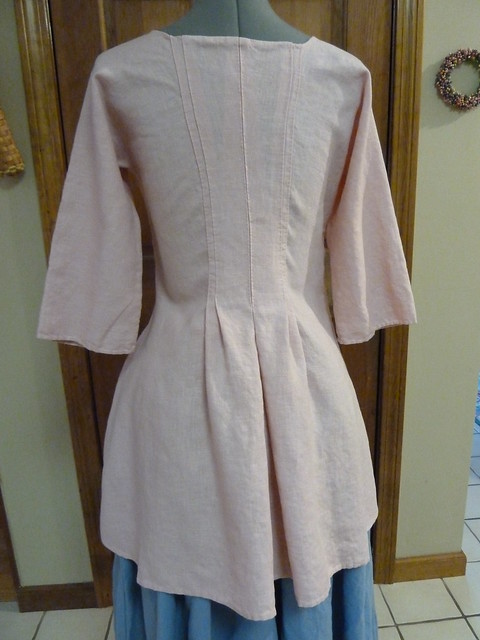
Back of the shortgown
The pattern: Because shortgowns are pretty consistent in shape, cut, and construction, it was very easy to adapt a single pattern and give it some variation based off of other examples. I scaled up one of the patterns in Fitting and Proper and slightly altered the front neckline (I prefer it slightly more square, though rounded is perfectly accurate as well) and changed the pleating pattern in back. I also lengthened it from the hip-length of the original to the mid-thigh length of the shortgown patterned in Costume Close-up (again, that's a change dictated by nothing more than personal choice).
General references on this type of garment and its history:
- Baumgarten, Linda and John Waston. Costume Close-up: Clothing Construction and Pattern 1750-1790. Williamsburg: Colonial Williamsburg Foundation, 1999, pp. 43-46.
- Baumgarten, Linda. Eighteenth-Century Clothing at Williamsburg. Williamsburg: Colonial Williamsburg Foundation, 1986, pp. 30-32.
- Burnston, Sharon Ann. Fitting and Proper: 18th Century Clothing from the Collection of the Chester County Historical Society. Texarcana: Scurlock Publishing Co., pp. 20-25.
- Felshin, Sue. "Of Gowns, Jackets, "Shortgowns, and Bedgowns: What Should I Really Be Wearing?" BAR Courier Jan/Feb 2001; reprinted here at 18th Century New England Life.
- Hersh, Tandy and Charles. Cloth and Costume 1750 to 1800. Carlisle: Cumberland County Historical Society, pp. 142-4.
- Kidwell, Claudia. "Short Gowns." Dress Vol. 4, 1978, pp. 30-65.
- McConnon, Rhonda. "The Shortgown and Bedgown." Online. http://www.18cnewenglandlife.org/short_gown.htm
For additional resources and patterns, see our earlier post on shortgowns.
Construction details: As always, this garment is entirely constructed by hand. It is by far one of the easiest and quickest projects I've ever done, from drafting to completion. First, I scaled up the pattern of the second shortgown in Fitting and Proper. Then I lengthened the pattern several inches so that I would fall at my mid-thigh, and cut it out. The next step was to sew the side seams, which closes both the sleeve and body seams because of the way the garment is structured. Because I was doing an unlined example, like the first short gown in Fitting and Proper, I used flat-felled seams to prevent the edges from raveling, with is consistent with that example.
The side seam, which extends from the end of the sleeve to
the bottom hem of the shortgown.
Now that the garment had some kind of shape, I put it on my dressform (which I don't like using for draping purposes because my stays won't fit on it, but Ashley wasn't around to be my body double!) and fiddled with the back pleats until I got a look I liked. In the two examples in Fitting and Proper, the back pleats are more or less parallel to the center back; they run vertically from neckline to waistline. I tried this pleating pattern, but wasn't quite happy with the boxy look it gave when I tried it on over my stays. To give it the illusion that the waist is smaller, I angled the pleats slightly, in exactly the same way I would do an English back gown. The pleats were then top-stitched down using a spaced backstitch.
Detail of the back with the tapered pleats.
Detail of the bottom of the pleats. The center back pleat is the
deepest, in keeping with the pleating patterns of en fourreau gowns.
Because the pleats end exactly at waist level, they release quite gracefully
into the "skirt" when an apron is tied around the waist.
Lastly, I turned all of the edges under and whipped them down. In the unlined short gown in Fitting and Proper, a facing strip is used to conceal the top of the pleats in the back; I opted not to use one because my fabric folded under quite easily, even with the pleats.
Back neckline.
This means that the ENTIRE garment it made out of one length of fabric, uncut and unpieced. Many extant examples are pieced to lengthen the sleeves (and sometimes to widen the "skirt"), but because my linen was 54", it provided plenty of room to make the shortgown in a single piece of fabric.
The unlined interior of the shortgown, with the back
pleating fully visible. All seams are felled to finish them.
For additional photos, check out the flickr album for this project.
The Fabric: A dusty pinkish/coralish linen, dyed by me (that in itself was an adventure!). Shortgowns in the eighteenth and early nineteenth century were made of linen, cotton, fustian, linsey, or wool. Stripes and prints are seen on extant examples.
Finishing the Look: Though an informal and relatively unfitted garment, a shortgown should still be worn over stays (and, of course, a shift!) and petticoat, and its neckline can be filled in with a kerchief. Some surviving examples are secured in front (neck and/or waistline) with ties, but the majority seem to have been closed with pins and were then further secured with an apron.
The shortgown "in action," properly accessorized with a kerchief and
apron. No, I'm not wearing stays, but that's because this was obviously
an exceptional situation (i.e. the stays workshop!).
Photo by Angela Burnley, linked from the Burnley and Trowbridge facebook page.
PS - I'm thinking of doing a detailed step-by-step tutorial (with lots of step-by-step photos again, of course!) on making a shortgown without a pattern, but want to be sure there is sufficient interest before I take the time to do another example and write it all up. If this is something you would be interested in reading, please leave a comment or drop us an email to let us know!

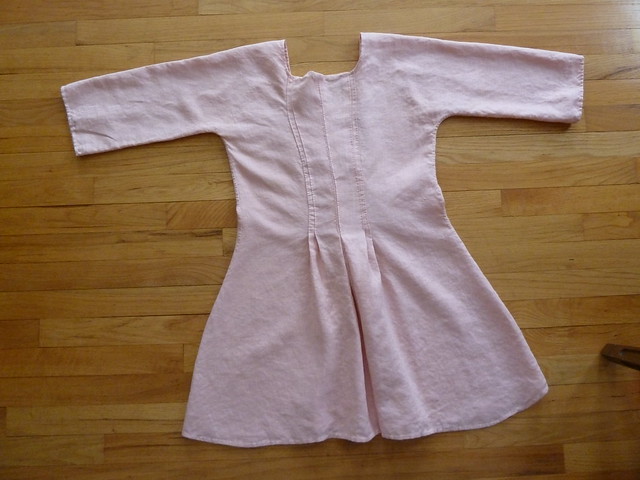
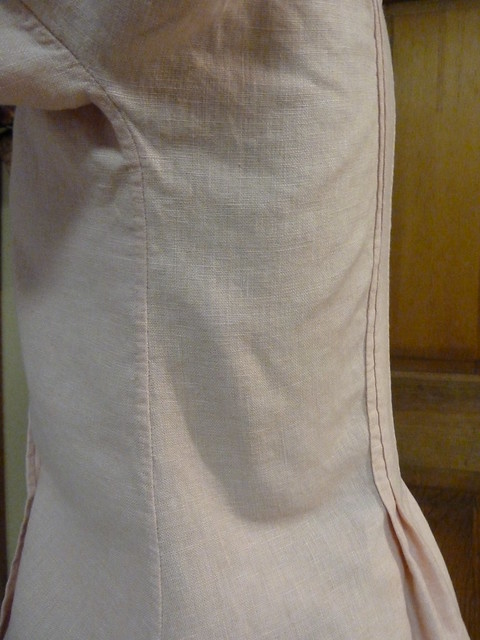
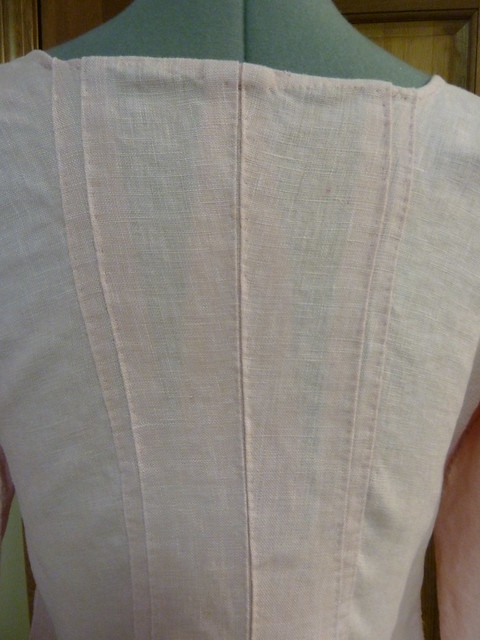
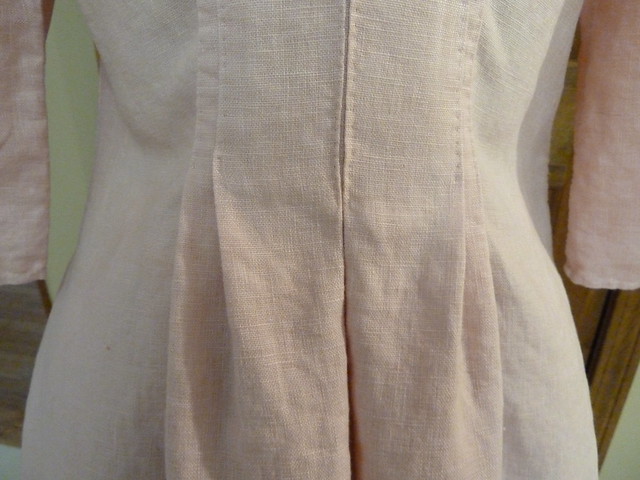
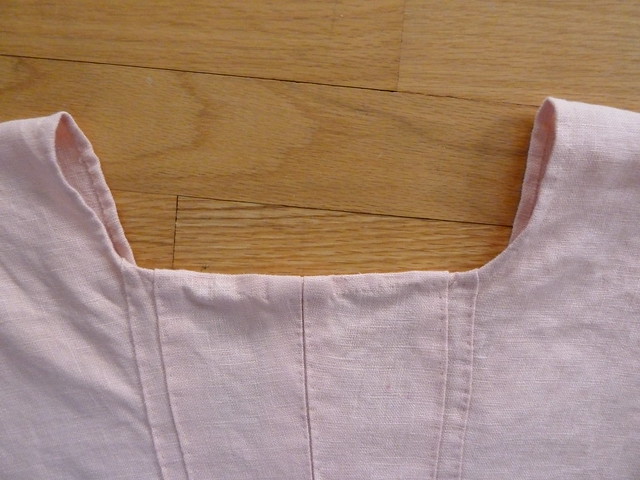


21 comments:
So that's what you were dying! I think it came out quite well!
Laurie
Haahaaa! Yes, that's what I was dying...and undying...and redying...and all the while desperately trying *not* to dye myself or the kitchen counter! :-) The picture that captures the actual color closest is the last one, from the workshop. For some reason, it looks awfully pale in all the other shots, but it's really quite rich and pretty.
My favourite Swedish book about extant clothes, Kvinnligt mode describes a quilted shortgown with this cut. I don't have the book handy right now and don't recall any particular details apart from the cut, but I can check it out, if you are interested. I can say this, at least, Quakers were never big in Sweden, so I can pretty safely say that it wasn't used by one. :)
Um, perhaps I should mention that all the clothes in it are Swedish and that they all have patterns and extensive nptes on construction. :)
Oooo, how I wish I could read Swedish because that book sounds wonderful! It doesn't come in translation (or perchance with a translator!) does it?! Heehee! ;-)
I agree that research into the shortgown definitely needs to be deepened because you're right - there are several Swedish examples (the one you cite, and the two on the Duran website, amongst others, I'm sure) that seem to contradict apparent American trends. Did the Swedish tend to settle in the mid-Atlantic region during the colonial period? If so, that would support the theory that the garment was predominantly worn in that area...but counter the suggested Quaker link.
All very interesting indeed! Thanks for sharing that example, and the book title! I might be tempted to buy it, despite its indecipherability! :-)
It's a very useful book and really should be translated! There some 40 female garments analyzed, from 1730-1869. It's my go-to book as I like to make clothes that I know were worn in Sweden, even if Sweden kept up with current fashion. :)
No, Swedes didn't start to move to America until the 19th century, in the 18th century it was illegal to move outside the country. There was no trade directly to America either, so there is no obvious link between the contries.
Sorry for spamming you with comments, but I checked my book and I thought you would find this interesting. The shortgown is dated to the 1740's and made of very fine linen, lined with a coarse linen fabric. It's clearly a garment for a woman by some means. It's in unpractical white and beautifully quilted. The quilting is clearly made with the finished garment in mind and not made by something previously quilted. The pattern has a rounded neckline and no pleats in the back, though a curved backseam for a better fit. I could send you some pictures if you want.
Isis, don't be sorry at all! I'm finding this so fascinating! I tried to find the book this morning, and can't find it available anywhere, either to buy or borrow through interlibrary loan. :-( I would *love love love* if you could send pictures! Oooo, how exciting! Our blog email is fashionablefrolick@yahoo.com. Thank you, thank you for offering!
Mary, I don't have any sort of background in sewing or garment construction, either! Neither my mother nor my grandmother are sewers so they couldn't teach me, and I only just last week took my first workshop. All that's to say that it really is easier to teach yourself than you think it might be! It just takes lots of reading and research, amd fiddling and trying things out, to learn how they did things "back then" to get the shapes and drapes they did. If you have any icky disposable fabric hanging around, try it out for yourself and see what happens - you might be pleasantly surprised at what you can do! :-)
You have my vote for doing a more extensive tutorial, and ooh, it would be great to hear more about the Swedish versions.
I too have searched and searched for the Kvinnligt mode book, and like you, cannot find a copy anywhere. Is it still sold in Sweden, and if so, where? Do you think they'd ship abroad?
Many thanks for a great post,
Natalie
I will send them tomorrow. :) Alas, the book sold out in Sweden very soon after it came and has never been re-printed, which is a shame. And odd, as I think it would sell very well. :(
Rebecca, I would love a shortgown tutorial. I have so far only made clothing for some girls who volunteer at a local 18thC house museum, but I hope to start on adult clothes in the near future.
As to the origin of the shortgown in the colonies, I think the Swedish connection is worth pursuing. Swedish sailors came to Delaware (US Mid_Atlantic) in 1638 and the first Swedish women and children followed in 1640. (www.kalmarnyckel.org) That colony only lasted about 15 years before being taken over by the Dutch, but the Swedes must have continued to have an important presence because in 1698 they built the oldest Protestant church in the New World and sent missionaries for 100 yrs after. (www.oldswedes.org) I don't know how the Swedish restrictions on emigration might have been played into all that though.
I can see how something as practical as a shortgown might have appealed to the Quaker women in the area.
This just keeps getting more and more intriguing! Thanks for all of that information, Laura! I'd definitely like to pursue further research into this (when I have time...haahaaa) because what little has been done is, as I mentioned and as you ladies have pointed out with your subsequent comments, preliminary in the extreme. Thanks so much, everyone, for your contributions to this great discussion.
Isis, I owe you an email! Thanks ever so much for taking the time to send the photos! :-) Oh how I wish I could find a copy of that book!!
It may take a few weeks, but I promise to do a shortgown tutorial as soon as I can, in plenty of time for summer events!
Ahh a patternless shortgown tutorial would be amazing! I have been wanting to make one with a lovely length of fabric out of my stash for some time now, but am too cheap to buy a pattern as all of my costuming funds at present have been used up by the Civil War era ;) I also considered drafting one, but this would be helpful and make it go much faster!
I love your blog, keep up the great work!
The dye job was especially lovely!
I'd been looking to make a short gown for some time now, and with your article, it certainly seems more do-able than I had originally thought!
A step-by-step guide would be amazing!
Yikes, has it really been a year since this post?! Where does the time go? Thanks for your comments, ladies. Knowing that there is still interest in a tutorial, we'll be certain to put it on our list of projects for the next couple of months. :-)
You've got a great site, I came across it today and look forward to reading it all!
I've seen that http://www.larsdatter.com/18c/women.html lists a lot of depictions and/or descriptions of shortgowns and bedgowns (the distinction is unclear), and although I'd love for the shortgown to be of Swedish origin, it seems to have been common in Europe in general.
It's lovely. I wish I could see the last photo, "in action". The link keeps taking me to my own home page :(
Anon, I just fixed the link - it should be back working now! :-)
Did you ever do the tutorial for this project. My granddaughter wants/needs a jacket since she out grew her 1 piece dress. Changed the skirt into a legitimate petticoat but stumped on a correctly sized short gown. Thanks for any help.
Did you ever do the tutorial for this project. My granddaughter wants/needs a jacket since she out grew her 1 piece dress. Changed the skirt into a legitimate petticoat but stumped on a correctly sized short gown. Thanks for any help.
Sorry for the duplicate post.
Post a Comment